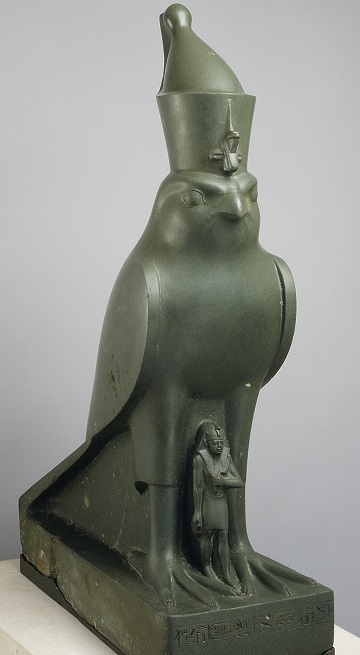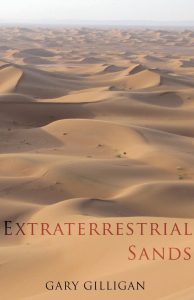The Egyptian Sky God Horus. Part 1 of 3.
Horus, “He who is above.” Guardian of the pharaohs & protector of the god king planets.

Horus protecting Nectanebo/Mercury.
Credit: The Metropolitan Museum of Art.
Left: The sky god Horus protecting the red disk of Mars (NOT THE SUN!) which at this particular time was named Ramesses (which means “Fashioned by Ra”), personified here as the young king. Right: A similar theme; Horus protecting Nectanebo II (Greek) otherwise known as Nakhthorheb which means “Strong is His Lord Horus.”
The Falcon-god Horus can be traced back to the dynastic period around 3100 BC and is one of the most famous gods of ancient Egypt. Usually depicted as a hawk or as a man with the head of a hawk, Horus was not only a god of the sky but the embodiment of divine kingship and protector of the reigning pharaoh. Gradually the cult of other hawk gods merged with that of Horus, and a complex array of myths became associated with him.
(Shaw & Nicholson, 2002, p 133)
Horus and the pharaohs (Horus in general)
In giving celestial identity to the very enigmatic god Horus in my first two books I offered the very simple formula: Horus = ruling god king planet. In regards to the god kings, I stand by this – the astral pharaohs when reigning over earth as ‘living gods’ were simultaneously embodied in the sky god Horus – he was, just as the literal sources reveal, the guardian of kingship. However, there is much more to this, and after much diligent research I am now in a position to elaborate and promote a much more comprehensive understanding of Horus and his many forms.
By using sacred imagery along with the Egyptians own divine words (taken at face value) it will be shown how Horus was essentially an omnipresent sky deity whose physical form was above all manifest in the god king planets. Furthermore, the subsequent many coexisting forms of Horus derived from the very same red-orbed Pharaonic planets (as Horus) undertaking prominent and distinctive traits (e.g. the winged disk) and dwelling in certain locations (e.g. ‘in’ or ‘on’ the horizon) for lengthy periods of time – enough time to warrant the invention of a new form of universal god Horus. In other words, without the kingly planets (& cosmic chaos) there would be no Horus, and no variant forms.
It will be further shown how Horus (and his many forms) was not the Sun or even some kind of vague mythical aspect of Re as many believe but a totally independent entity, and should be treated as such. This would include the apparent composite god Re-Horakhty (which really is the crux of the matter) and Horus Behdety (winged disk), again, not the Sun! They held physical presence in the same celestial sphere and certain text refer to Horus as the son of Re, but they were independent deities, moreover, worshiped as such. Only when the planets began to settle into their current orbits did the many forms of Horus slowly merge into one, leaving behind a legacy of enigmatic myths.
Horus, Lord of the Skies
Establishing the origins of Horus and how the Egyptian kings became Horus incarnate.
The process of a planetary body becoming Pharaoh and the ‘Living Horus’ born to the skies of earth, as you would expect, involved a myriad of cosmogonical deities (Re, Isis, Hathor, Amun, etc.). By using the Ramesses the Great (‘Fashioned by Re.’ Clayton COP) as just one of the many guises of an incandescent red Mars, a rough sequence of events would go something like this.
Ramesses/Mars begins life as a very large star. In this form Ramesses/Mars is to be equated with Osiris, the quintessential god of the afterlife and the duel world above, which the Egyptians called Upper Egypt (the hemispherical dome of heaven perceived as a fixed land mass). Osiris is to be seen as a deity attributed to no one particular body but all that appeared in ‘star form.’ A god that basically transported the dead to be reborn as a star (akh) in the firmament above, just as the Egyptians tell us.
Ramesses/Mars moves closer to earth and in doing so magnifies in size, slowly shedding its white Osirian linen bandages (star-like quality) to reveal a hazy red disk, in the image of Re, the Red Sun (hence, the kings were ‘Offspring of Re’). Born amidst the general location of the ecliptic (apparent path of the Sun and planets) Ramesses/Mars at this stage is perceived to be a ‘young Horus.’ In giving birth too countless bodies, as well as playing a preliminary role in escorting them to the vibrant land above, this portion of the sky was deified as the mothering goddess Isis, which we will discuss shortly.
Ramesses/Mars further magnifies in size, so much so it looms larger than the Sun (Re), and all other bodies. In a size determining factor here (from an earthly perspective), such an exalted status deems Ramesses/Mars god king of Egypt – the unifier of the ‘two lands’ of Upper (heaven) and Lower Egypt – an intermediatary between the moral and the divine. Moreover, Ramesses/Mars now becomes the ‘Living Horus,’ and ‘Lord of the Sky.’
Note; as the record shows, it was the gods (through ‘divine order’) that dictated kingship throughout the ancient world. An understandable situation given the God King Scenario.
Under the authority and guardianship of a range of cosmogonical deities (Horus, Re, Amun, etc.) Ramesses/Mars reigns over earth for a period of time, this paralleling the historical account (e.g. Ramesses II, 68 years). His very colourful life (battle campaigns, marriages, fathering over 150 children, etc.) is recorded via scared inscriptions and images throughout Egypt (sacred writings = events above).
Ramesses/Mars appears to move away from earth (temporary death) and in doing so is slowly transformed into a star (Osiris) once again.
“The king has come to his throne which is upon the Two Ladies and the king appears as a star.” (Pyramid Text Utterance 248)
This process would involve a red orbed ‘spinning’ Mars slowly becoming cocooned/wrapped in white ‘star-like’ material or, as the Egyptians believed, white linen bandages as Ramesses/Mars is mummified in preparation for rebirth in the Egypt above. Assisting in the mummification process was the blackness of space, which was deified as the ‘black’ jackal-headed god Anubis. The attributes of Anubis drawn from the natural world as jackals were observed loitering around cemeteries, thus perceived to be guardians of the dead (note; no such species as black jackals).
As a star, Mars has transformed from a living Horus (son of Isis and Osiris) into the god Osiris (star-form) and is subsequently named Ramesses-Osiris. He now begins the very perilous journey (chaos) to the duel world above, to be reborn in whatever form he so chooses. As the record shows, this process was repeated over and over again.
As Mars appears to move back and forth between the two lands of heaven and earth, it is named and renamed numerous time over, as too were the other perpetrators of chaos. The sacred names, titles and epithets given to the astral monarchy primarily dictated by their location, attributes and appearance in respect to Egypt’s more prominent gods e.g. the Sun god Re gives us kingly titles such as ‘Appearing like Re,’ ‘Rising like Re’ and ‘Shinning like Re,’ and the deified global aurora (Amun) gives us ‘Beloved of Amun,’ and similar titles (see Names and Titles).
The above gives us a brief process of how planetary kings became embodied in the ‘Living Horus.’
The following inscriptions leave us in no doubt of the kings astral status as the god Horus.
Usermare-Setepnere (Ramesses II) given life, in […] giving to thee myriads of years, eternity upon the Horus-throne of the living.
(Breasted, Ancient Records of Egypt, Vol III p 115)
His majesty (Tuthmosis) is Horus, assuming his (i.e. Horus’) kingdom of myriads of years.
(ibid, Part Two, p 73)
Year 1, Akhet (month) 4, day 19, under the majesty of Horus…
Lord of the words of the gods, who appeared on the Horus throne of the living daily like his father Re.
All their life and health was (from) the nose of the mighty king, the Horus, who repeats births, the beloved son of Amen-Re, king of the gods, who had begotten him so that he would be created, of the king of Upper and Lower Egypt.
(Tutankhamen’s Restoration Stela)
Grant that he rest upon thy throne as Horus, the Mighty Bull, beloved of Ma’at.
(Papyrus Harris, Breasted, Ancient Records of Egypt, Part Four, p 351)
It is well known and well attested to that Horus was a sky god, this raises the question, how can an earth bound king be the ‘Lord of the Skies?’ The God King Scenario promotes the idea that we take the Egyptians at their word, this will prove to be far more productive than invoking a surreal world we don’t understand.
The phrase “… the Horus, who repeats births….” is explained thus. Mars appeared to move back and forth in an endless cycle of death and rebirth (morphing between a red orb and a star). Each time it was born to earth it became Horus incarnate, more specifically “Horus, who repeats births.”
A very common phrase…
“….shining upon the Horus-throne of the living, like his father, Re, every day…”
(Ibid Vol III p 118)
Raises the obvious question, how can humans shine ‘like the Sun?’
Taken at face value, the text also make it very clear that two totally separate deities are being referred to here, insofar as, Ramesses shines on the Horus throne ‘like’ (thus separate too) the Sun.

Credit photo: Arnvid Aakre; www.egyptmyway.com
With the above in mind, the iconography becomes virtually self-explanatory. For example, the photo at the top of the page depicts the ‘good and just’ god Horus protecting the disk of a young Ramesses/Mars. Similar iconography can be found in the image on the left where the pharaoh Khafre’s head and neck are physically embraced by the wings of the protective sky god Horus. According to almost every single book on ancient Egypt, art such as this is believed to be ‘idealized’ – the Egyptians were somehow tying to conceptualise an ideal world, or so the theory goes. Are they correct? Absolutely not! All Egyptian art derives from catastrophic events in the heavens. ‘Idealised’ is a term used by scholars who fall well short when it comes to understanding ancient minds.
The Horus-Name

Horus name written within a Serekh. Credit: Guillaume Blanchard.
The oldest known part of the royal titulary is the Horus-name. The kings were given the Horus-name upon
enthronement, or upon ‘outsizing’ thus ‘outranking’ all other bodies. On the right we have a very fine example of a Horus name written within a Serekh. What follows is a few Horus names given to the kings which are clearly celestial in connotation (after all, Horus was a sky god!)
- Hor-Aha “The Fighting Hawk.”
- Den “Horus Who Strikes.”
- Djet “Horus Cobra” (one shown).
- Djoser “Divine of the Body.”
- Tutankhamun “Strong Bull, Fitting From Created Forms.”
- Tuthmosis (Moon) “Horus Mighty Bull, Arising in Thebes.”
- Neferefre “Horus, Beautiful Of Apparitions.”
(Source: Clayton, Chronicle of the Pharaohs)



